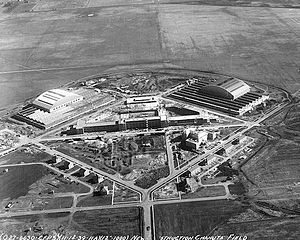Chanute Field
| Chanute Air Force Base Chanute Field |
|
|---|---|
| Located in Rantoul, Illinois | |

Chanute Field, Illinois, 12 November 1939. Note the lack of concrete runways.
|
|
| Coordinates | 40°17′40″N 088°08′35″W / 40.29444°N 88.14306°W |
| Type | Air Force Base |
| Site information | |
| Controlled by |
|
| Site history | |
| Built | 1917 |
| In use | 1917–1993 |
| Battles/wars |
World War I World War II |
| Garrison information | |
| Garrison | 3345th Air Base Group, (1948 - 1993) |
Chanute Air Force Base is a decommissioned United States Air Force facility, located in Champaign County, Illinois, south of and adjacent to Rantoul, Illinois, about 130 miles (210 km) south of Chicago. Its primary mission throughout its existence was Air Force technical training. Chanute Field was established on 21 May 1917, being one of thirty-two Air Service training camps established after the United States entry into World War I.
The base was closed in 1993 and is currently being redeveloped for civilian uses.
Chanute Field was named in honor of Octave Chanute (1832–1910), a pioneer aeronautical engineer and experimenter, and friend and adviser to the Wright Brothers. Chanute's biplane glider (1896) with "two arched wings held rigidly together by vertical struts and diagonal wire bracing" (the principle of the Pratt truss used in the railroad bridges which Chanute constructed) served as a prototype design for airplanes.
Although the United States had been the birthplace of powered flight, the Army Signal Corps paid little attention to it. Even as World War I progressed in Europe, America did little to build its air strength. In April 1917, the United States was woefully weak in the air. The United States possessed only one fully manned and equipped Aero squadron (1st Aero Squadron), and about 250 aircraft outfitted the Aviation Section of the Army's Signal Corps. In comparison, France began the war with over 1,500 aircraft.
To meet the demand, Congress appropriated $640 million to build up the Air Service. The War Department immediately opened ground schools at eight colleges and established twenty-seven flying fields to train pilots. The War Department selected Rantoul because it was one of the few level sites in Illinois in close proximity to the Illinois Central Railroad and the ground school at the University of Illinois. The village of Rantoul would also be a source for electricity and water.
...
Wikipedia
